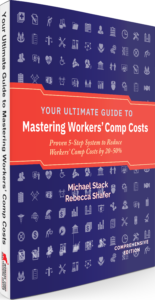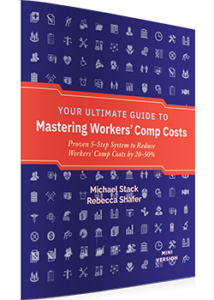Risk Management Industry’s #1 Training Manual
Workers’ Comp Cost-Reduction Guide Book
Save 20%-50% on Your Workers’ Compensation Costs!
Our guidebook is based on decades of the combined hands-on field experience of the industry’s leading cost-reduction expert and the most-respected professional organization. The book covers how to:
► Assess your workers’ compensation program.
► Design the most cost-impacting strategy.
► Roll out comprehensive changes to your organization.
► Monitor and manage the program going forward.
Learn the Basics of Workers Comp
- Fundamentals of Cost Containment
- Training
- Injury Management Roles
- Reporting Claims
- Post-Injury Response
- Communication with Employees
- Working with Claims Administrators
- Safety &Loss Control
- Wellness Programs
- Return to Work and Transitional Duty
- Other Indemnity Cost Containment
- Directing Medical Care
- Medical Cost Containment
- Fighting Fraud
- Rehabilitating the Injured Workers
- Managing Prescription Drug Use
- Claims Resolution and Settlements
- Federal Employees Compensation Act
Our Book Will Help You Answer These Questions:
- Can you define the purpose of workers’ compensation?
- Do you know who pays for workers’ comp?
- Can you identify the seven main parties involved in the program?
- What are the five benefits to the employer?
- Why you need to know 10 differences between an employee and an independent contractor?
- What are four types of benefits paid to injured workers?
- Can you distinguish between the various types of covered injuries?
- How is a work-related injury defined?
- What is the difference between aggravation and exacerbation of claims?
- Do you know the difference between statutory coverage and employer’s liability coverage?
- How does Federal Employee’s Compensation differ?
- There are six ways losses are categorized. Do you know them?
- How are losses reported?
- What is meant by “mod” and how does it affect your premium?
- Can you name the 13 types of insurance structures?
Who Benefits From Our Cost-Reduction Guidebook?
The principles in our guidebook apply to any state, jurisdiction, or country. The program improves internal communications and operational best practices of employers. No matter where you are trying to train risk managers, this book will work for you! Of course, you will need to coordinate any new policies including those in our book with your in-house team of professionals.
- Risk Managers and Safety Directors use this book to train supervisors in workers’ compensation claims management. They learn more about their area of responsibility – post-loss cost containment – adding to their overall knowledge. This book is also used to get management commitment in rolling out a Return-to-Work program, one of the biggest cost savings areas relating to workers’ compensation costs.
- Brokers, Agents, Insurance Companies, Reinsurers, Adjusters, and Consultants use this book for prospecting and to learn about specific aspects of cost containment; and benefit by passing their knowledge on to their clients. For example, when discussing how to develop a Return-to-Work program and a client asks about “off-site return-to-work programs,” the broker quickly finds that section in the book, reviews it, and passes the answer on to the client, along with a copy of the cost containment book. The book becomes a “lesson plan” tool.
- Producers and Account Executives give the book to prospects during formal presentations such as annual stewardship meetings to illustrate how their company is on top of workers’ compensation issues. The book also makes a good client gift.
- Vendors such as doctors, investigation firms, law firms, medical management vendors and triage companies learn how their services might fit into the workers’ compensation marketplace. They learn what is important to employers, and what they look for in medical provider relationships. Many also private-label the book and give it to prospects to show them how the services fit together.
- Human Resources find it useful in bringing new hires including risk managers, safety professionals and supervisors, up to speed very quickly. Often the HR Director is responsible for some aspect of workers’ compensation or disability leave, and needs to understand more about workers’ compensation cost containment methodology.
DISCLAIMER: Do not use this information without independent verification. All laws vary and change frequently. Consult your attorney, insurance broker/agent, or another professional you select about workers’ compensation or other issues. Do NOT rely on information contained on this website.



